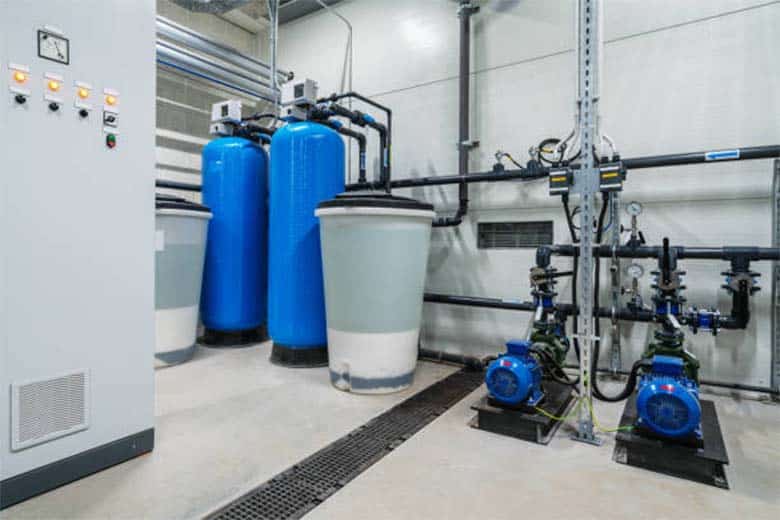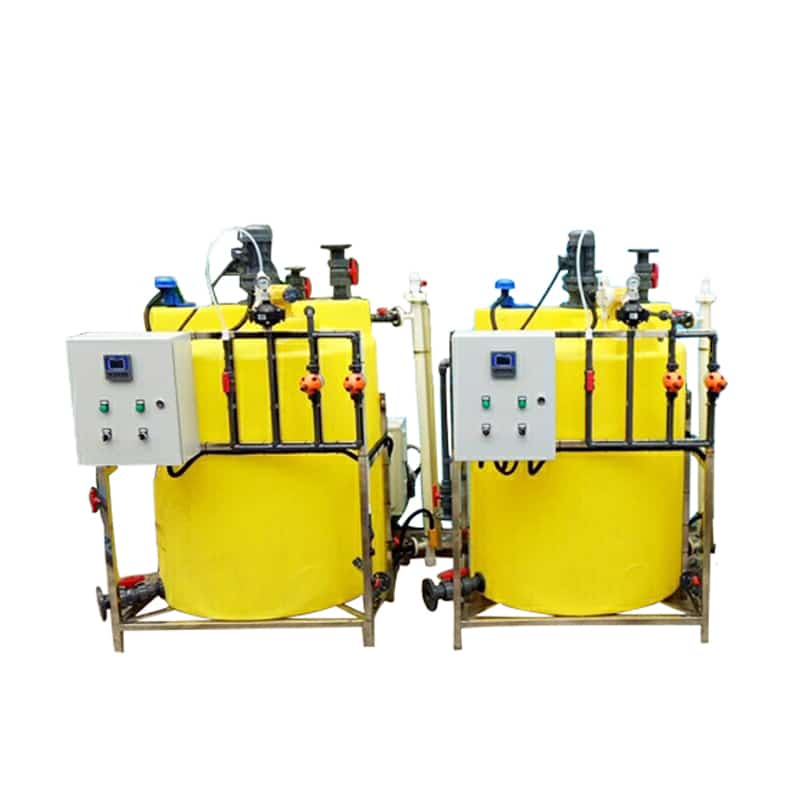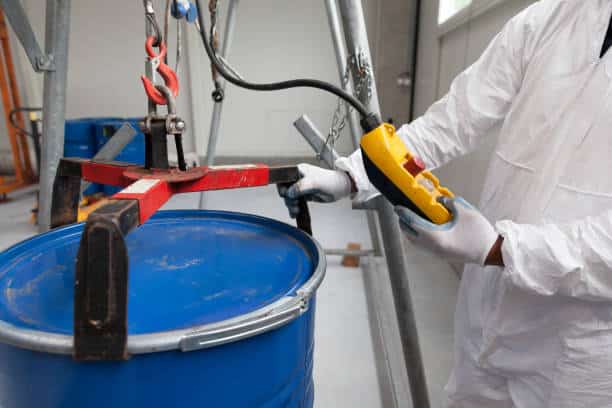Chemical Injection Skid

What is chemical injection skid?
What is the meaning of “skid” in chemical injection skid?
“skid” in the context of “chemical injection skid” means a support and base structure for a device. In engineering and manufacturing, “skid” means a mobile platform or frame with supports, bases and bracing structures, typically used to support and secure equipment or machinery. In the context of “chemical injection skid”, “skid” means that the chemical injection unit is mounted on a platform or frame that enables it to be easily moved, installed and maintained.
The overall meaning of “chemical injection skid” is a system that includes components such as chemical storage, pumps, control systems, and support bases to accurately and safely inject specific chemicals into a fluid or system in an industrial process. This system is usually manufactured and installed as a single unit for easy movement, integration and maintenance to meet the needs of chemical handling in different industrial applications such as corrosion inhibition, pH adjustment, disinfection etc. Overall, it is an integrated unit for chemical handling(Chemical Dosing System).

The design helps simplify the installation and integration of the chemical injection skid and makes it a self-contained unit that can be easily moved to the desired location.” The “skid” can also include associated support structures, piping connections and safety equipment to ensure the stability and safety of the chemical injection skid. This structural design makes the chemical injection skid easier to integrate with industrial processes and provides flexibility and convenience.
How Chemical injection skid works?
The working principle of a chemical injection skid involves the precise injection of specific chemicals into the fluid stream of an industrial process to meet specific process requirements. The following are the basic operating principles of a chemical injection skid:
Typical working principle:
- Chemical storage: Chemicals are usually stored in specialized storage containers such as tanks, drums, gas bottles or other suitable containers.
- Connection and supply: The storage container is connected to the chemical injection skid. This may involve piping, pumps, valves and safety equipment to ensure that the transfer of chemicals from the storage container to the injection unit is safe and controlled.
- Injection process: The chemical injection skid is responsible for taking the chemical from the storage vessel, precisely controlling the flow and injecting it into a designated location in the industrial process.
- Control and monitoring: Chemical injection skids typically have control systems and monitoring equipment to ensure accurate injection of chemicals and to monitor the conditions of the industrial process.

Storage containers are usually located next to or near the chemical injection skid so that they can be easily filled and replaced. The design and configuration of the unit will be optimized to the needs and requirements of the particular application to ensure safe, accurate and reliable injection of chemicals into the industrial process.
Chemical storage and supply
Chemical injection skids typically include tanks or containers for storing chemicals. These tanks typically include corrosion inhibitors, disinfectants, corrosion inhibitors, etc., depending on the needs of the application. Chemicals are stored in these tanks ready to be supplied to the process stream.
Pumps
The unit typically includes one or more pumps that are used to pump the chemicals and inject them into the process stream. These pumps are usually able to precisely control the flow rate to ensure accurate chemical injection.
Flow control
Chemical injection skids are equipped with flow meters to monitor and control the flow of chemicals. The flow meter measures the rate at which the chemical is injected to ensure that it matches the process requirements. This data is typically fed back to the control system.
Control systems
The control system is usually based on a PLC (Programmable Logic Controller) or other controller. It monitors the data from the flow meter and other sensors and adjusts the pump operation according to predetermined parameters to ensure accurate chemical injection.
Safety features
Chemical injection skids typically include safety features such as pressure relief valves, emergency stop buttons, etc. to prevent system overpressurization or other hazardous situations.
Mixing and dilution
In some applications, chemicals may need to be mixed or diluted with other substances prior to injection. Chemical injection skids may include mixing tanks and dilution equipment to prepare the proper chemical concentration.
Chemical injection point
This is a specific location in an industrial process where chemicals are introduced to meet specific process requirements. Injection points are usually located in pipelines, storage tanks or other process equipment.
Monitoring and adjustment
The unit also includes various sensors and instrumentation such as pressure sensors, temperature sensors, level sensors, etc. to monitor process conditions and ensure the stability and safety of the chemical injection process.
Base structure of chemical injection skid
- Base frame: The base frame is the support structure for the entire unit and is usually made of steel or other suitable material. It provides support and stability to ensure that the unit can operate safely.
- Scaffolding or support legs: Scaffolding or support legs are usually attached to the bottom of the base frame and are used to raise the unit off the ground for ease of movement and installation, as well as to improve ventilation and avoid direct contact with the ground.
- Fixed brackets: Fixed brackets are typically used to securely fasten chemical storage tanks, pumps, piping and other components to the base frame to prevent them from moving or tilting during transportation or operation.
- Pipe supports: Pipe supports are used to support and secure piping systems that transport chemicals, ensuring that they are in the correct position and reducing the effects of vibration and stress on the piping.
- Non-slip surfaces: The surfaces of base structures are usually designed to be non-slip to provide worker safety and prevent accidental slipping.
- Vibration and vibration isolation devices: In some cases, vibration and vibration isolation devices may be integrated into the base structure to reduce the effects of vibration on the equipment and piping system, thereby improving the stability and performance of the unit.
The design of the base structure can vary depending on the size of the chemical injection skid, the application and the requirements of the operating environment. The goal of these components is to provide support, stability and safety to ensure that the chemical injection skid can operate reliably and be adapted to its intended operating environment.
What are the types of chemical injection skids?
There are several types of chemical injection devices, each suitable for different applications and needs. Below are some common types of chemical injection devices:
- Chemical injection pump: This device uses a syringe pump to inject chemicals into a fluid process at a precise flow rate. It is typically used in applications that require precise control of chemical dosing, such as water treatment, wastewater treatment and chemical treatment in industrial processes.
- Chemical injection systems: These systems typically include syringe pumps, chemical storage tanks, piping, control systems and monitoring equipment. They can be used to automate chemical dosing to ensure the accuracy and stability of chemical treatment.
- Chemical misting systems: These systems introduce chemicals into the treatment area in the form of a mist or spray, and are typically used for cooling, disinfection, odor control, and other applications. Chemicals are sprayed into the air or water to achieve the desired effect.
- Gas injection systems: Gas injection systems are used to inject gases into a fluid process to improve the properties or reactions of the fluid. For example, oxygen can be injected into a wastewater treatment process to promote biodegradation.
- Chemical mixing systems: These systems are used to mix and dilute chemicals to achieve the desired concentration in the treatment process. They typically include mixing tanks(Tank Agitator Mixer), pumps and control systems.
- pH adjustment systems: These systems are used to automate the adjustment of pH levels during the treatment process and typically include acid and alkali tanks, syringe pumps and feedback control systems.
- Coating and spraying systems: These systems are used to apply coatings or paints uniformly to surfaces, such as automotive paint spraying, paint production or paint application in construction work.
- Oilfield chemical injection systems: In oilfield and natural gas production, chemical injection systems are used to inject a variety of chemicals, such as corrosion inhibitors, corrosion inhibitors and production enhancers, to maintain and improve the performance of the wellhead.
How is a chemical injection skid used in water treatment?
Chemical injection skids have a wide range of applications in water treatment to improve water quality, treat contaminants in the water, maintain system performance, and ensure compliance with water quality standards. The following are some common applications of chemical injection skids in water treatment:
- Disinfection: One of the most common applications of water treatment is disinfection. Chemical injection skids are used to inject chlorine, sodium hypochlorite, ozone, or other disinfectants to kill bacteria, viruses, and other microorganisms in the water to ensure the safety of drinking and industrial water.
- pH adjustment: The pH of water is a measure of its acidity or alkalinity, and different applications require different pH levels. Chemical injection skids can be used to add acidic or alkaline chemicals to adjust the pH of water to ensure it is within the desired range.
- Reservoir treatment: Reservoirs used for water supply or industrial purposes often require treatment to remove suspended particles, organic matter and microorganisms. Chemical injection skids can be used to add coagulants and flocculants to encourage particles to clump together for subsequent settling or filtration.
- Scale and corrosion inhibitors: Scale inhibitors are used to prevent the deposition of hard water salts in water treatment systems, while corrosion inhibitors are used to minimize corrosion of pipes and equipment. Chemical injection skids can add these chemicals to protect the water treatment system.
- Color and turbidity control: Some water sources may contain color or turbidity problems that can be associated with organic or inorganic impurities. Chemical injection skids can be used to inject chemicals to reduce the color and turbidity of the water.
- Iron and manganese removal: Iron and manganese in water can lead to unpleasant tasting water and damage to equipment. Chemical injection skids can be used to inject an oxidizing agent that precipitates and removes these metals.
- Fluoride regulation: In some areas, fluoride levels in water can be too high or too low. Chemical injection skids can be used to control fluoride levels to meet health standards.
- Desalination: In the desalination process, chemical injection skids can be used to inject desalination chemicals, such as inhibitors in reverse osmosis membrane systems, to remove salts and other impurities.
These applications are just examples of chemical injection skids used in water treatment. By precisely adding and mixing chemicals, these devices help to improve water quality, ensure the efficient operation of water treatment systems, and meet regulatory and sanitary requirements. In addition, they reduce operating costs and increase the efficiency and sustainability of water treatment.

How do I go about selecting the right pump for different types of chemical injection skids?
| Type of Chemical Injection System | Suitable Pump Types | Considerations | Applications |
| Chemical Injection Pump | Peristaltic Pump, Centrifugal Pump | Chemical properties (corrosiveness, viscosity, etc.) Flow and pressure requirements, Material compatibility, Accuracy requirements | Water treatment, Wastewater treatment, Industrial chemical processes |
| Chemical Mixing System | Plunger Pump(HJ-Z Mechanical Dosing Pump), Screw Pump | Working pressure and flow requirements for the mixing system, Design requirements for the mixing tank used, Chemical properties | Chemical mixing and dilution, Solvent mixing |
| Gas Injection System | Pneumatic Pump, Diaphragm Pump(H Solenoid Dosing Pump) | Type and pressure requirements of the injected gas, Chemical corrosiveness, Safety considerations | Gas flotation in wastewater treatment, Gas transfer and inflation |
| Acid-Alkali Regulation System | Plunger Pump, Peristaltic Pump | pH regulation range and stability of acid-alkali liquids, Flow requirements, Material compatibility | pH regulation in wastewater treatment, Control of chemical reactions |
| Coating and Spraying System | Gear Pump, Centrifugal Pump | Viscosity and flow requirements of the coating or paint, Surface area and speed of spraying or coating, Precision requirements | Automotive painting, Paint production, Coating in construction projects |
Material compatibility of chemical injection skid
Material compatibility of chemical injection skids is critical, as different chemicals may corrode or react with the components of the unit to varying degrees. Choosing the right materials ensures that chemicals can be transferred and handled safely and efficiently while extending the life of the device. The following are some common material compatibility considerations:
- Stainless steel: Stainless steel is a commonly used corrosion-resistant material and is commonly used to handle a wide range of chemicals, including acids, alkalis and oxidizing agents. However, different types of stainless steel (e.g. 304, 316) have different corrosion resistance to different chemicals, so it is important to choose the right grade of stainless steel.
- Plastics: Plastic materials such as polypropylene, polyvinyl chloride (PVC), polypropylene (PP), and fluoroplastics (e.g., polytetrafluoroethylene PTFE) are commonly used to handle acid and alkaline chemicals, but their corrosion resistance varies depending on the nature of the chemicals.
- Rubber: Rubber materials such as fluoroelastomer (e.g., Viton) and silicone rubber are commonly used to handle organic solvents, acids, alkalis, and certain oxidizing agents, but are not applicable to all chemicals.
- Glass: Glass is a material with excellent compatibility with many chemicals, especially for laboratory applications or high purity chemical handling.
- Metals: Some metal materials, such as titanium and Hastelloy, have good corrosion resistance to some strong acids, bases and oxidizing agents, but are usually more costly.
- Ceramics: Ceramic materials have excellent corrosion resistance in some high temperature and strong corrosive environments.
- Composites: Certain composites, such as glass fiber reinforced plastics, have good corrosion resistance and strength for specific applications.
The selection of appropriate materials requires a detailed knowledge of the nature of the chemical, including its pH, temperature, concentration and any other properties that may cause corrosion or reaction. In addition, materials should be selected based on operating conditions (e.g. pressure and temperature) and the design requirements of the installation. In all cases, relevant regulations and standards should be followed and installations should be regularly inspected to ensure safety and reliability of performance.
Environmental impacts of chemical injection
Chemical injection plays an important role in applications such as industry and water treatment, but can have a number of potential impacts on the environment if not properly managed and monitored. The following are some of the environmental impacts associated with chemical injection:
- Pollution of water bodies: Incorrect injection and handling of chemicals can lead to the introduction of hazardous substances into water bodies, polluting groundwater, rivers, lakes or oceans. This may have negative impacts on aquatic organisms and ecosystems.
- Soil contamination: Spillage or improper disposal of chemicals can lead to soil contamination, which can affect plant growth and soil quality.
- Atmospheric emissions: Some chemicals may be released into the atmosphere during disposal, especially volatile organic compounds (VOCs) and gases. This may have an impact on air quality and in some cases lead to photochemical pollution.
- Ecological impacts: The release of chemicals and pollution may have long-term effects on the surrounding ecosystem, including adverse effects on the survival and reproduction of plants, wildlife and microorganisms.
- Health risks: Contaminated water and air may pose a risk to human health, especially if drinking water sources are contaminated. Some chemicals may be acutely or chronically toxic to humans.
- Groundwater decline: The injection of certain chemicals may lead to a decline in groundwater levels, negatively affecting the sustainability of water resources.
- Waste generation: Waste and wastewater from the treatment of chemical injection skids need to be properly handled and disposed of to prevent them from further contaminating the environment.
In order to mitigate these potential impacts, a number of preventive measures and best management practices must be implemented, including:
- Follows strict environmental regulations and standards to ensure safe and compliant operations.
- Use chemical storage and delivery systems with good material compatibility.
- Regularly inspect and maintain chemical injection units to prevent leaks and malfunctions.
- Manage waste and wastewater appropriately and comply with waste disposal regulations.
- Monitor and report environmental impacts, as well as take corrective action as necessary.
Summary
A chemical injection skid is a critical piece of equipment used to accurately inject specific chemicals into an industrial process to ensure process safety and efficiency. It includes chemical storage vessels, pumps, flow meters, control systems, and safety features for handling liquid chemicals for a variety of applications such as corrosion inhibition, pH control, and sterilization. The design and material selection of these units is critical to accommodate different chemicals and operating conditions while minimizing the potential impact on the environment.
HAOSH offers a wide range of water treatment dosing products and solutions, mainly supplying dosing metering pumps, such as solenoid dosing pump, mechanical metering pumps, hydraulic metering pumps and dosing systems. Feel free to contact us.
